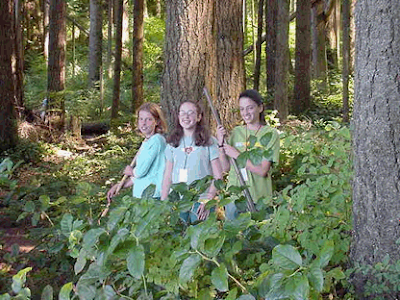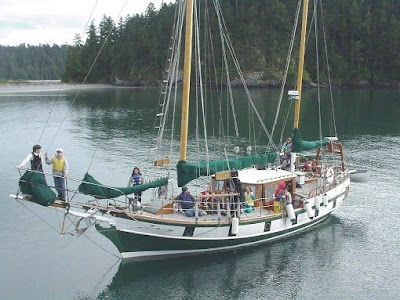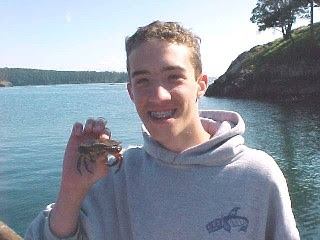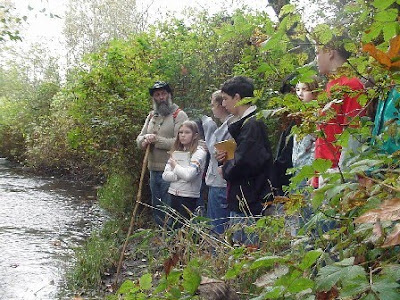Eileen McMackin had a dream, a dream that would benefit others. Her dream was to have a school that focused on environment and stewardship, and encouraged students to be leaders. Learning about and experiencing nature would not be an isolated class, but would be integrated into the academics of a middle school curriculum. Ms. McMackin got her chance to share her idea when Superintendent, Ron Barnes, asked teachers to come forward with ideas for staff-initiated schools that would fill the needs of students and their families in Lake Washington School District.
Ms. McMackin drew many of her ideas from the experiences that she and her own children had in camp settings and youth service projects. Founding a school that would provide a community for students was very important to her. As her discussion with Ron Barnes ended, he stated, "It sounds like you have a school!" Through the following year she worked with three other teachers, Wayne Tannhauser, Brian Healy, and John Hamilton to turn the vision of a school into a reality. Then, in 1999 it happened, the Lake Washington School District Environmental and Adventure School opened its doors to students.
 Eileen McMackin had a dream, a dream that would benefit others. Her dream was to have a school that focused on environment and stewardship, and encouraged students to be leaders. Learning about and experiencing nature would not be an isolated class, but would be integrated into the academics of a middle school curriculum. Ms. McMackin got her chance to share her idea when Superintendent, Ron Barnes, asked teachers to come forward with ideas for staff-initiated schools that would fill the needs of students and their families in Lake Washington School District.
Eileen McMackin had a dream, a dream that would benefit others. Her dream was to have a school that focused on environment and stewardship, and encouraged students to be leaders. Learning about and experiencing nature would not be an isolated class, but would be integrated into the academics of a middle school curriculum. Ms. McMackin got her chance to share her idea when Superintendent, Ron Barnes, asked teachers to come forward with ideas for staff-initiated schools that would fill the needs of students and their families in Lake Washington School District.Ms. McMackin drew many of her ideas from the experiences that she and her own children had in camp settings and youth service projects. Founding a school that would provide a community for students was very important to her. As her discussion with Ron Barnes ended, he stated, "It sounds like you have a school!" Through the following year she worked with three other teachers, Wayne Tannhauser, Brian Healy, and John Hamilton to turn the vision of a school into a reality. Then, in 1999 it happened, the Lake Washington School District Environmental and Adventure School opened its doors to students.
Camp Hamilton
To introduce a strong sense of community and belonging, and to start each year immersed in environmental studies, we spend a week at Camp Hamilton. Camp Hamilton is a great place to learn about the flora and fauna of northwest forests and wetlands.
Located northeast of Duvall, up a bumpy country road, it is very secluded and protected. It also has a variety of ecosystems. There is a lake, where students learn about the insects that live on or near the water. A healthy forest encompasses the whole camp, where we learn about succession and how to identify dominant trees and plants. The lake-edge marshes, accessible by canoe, are filled with moss covered snags and submerged logs. There is also a section of land bordering the camp that has been logged, so students can see the changes in habitat brought about by the removal of trees.
Lake Hannan is located in the center of the camp. It is great for kayaking, canoeing, and swimming, and water quality investigations. In a study of macrobiotics, we wade into the lake with insect nets, skimming the top of the water for insects. We place our samples in cups for a closer look. Using identification charts, and hand held magnifying glasses, we classify the insects before returning them to the lake. The kind and quantity of insects is an indicator of the health of a fresh water ecosystem. We learn that Lake Hannan is a healthy, clean lake. (Although some of us are a bit squeamish about swimming after our insect investigation!)
 In the forests, we experience lessons on succession and soil layers. We learn the key characteristics of the Douglas-fir, western red cedar, and western hemlock trees. We learn about the healing power of sword fern spores, taste wild huckleberries, and build debris shelters that could be used to survive a night in the forest.
In the forests, we experience lessons on succession and soil layers. We learn the key characteristics of the Douglas-fir, western red cedar, and western hemlock trees. We learn about the healing power of sword fern spores, taste wild huckleberries, and build debris shelters that could be used to survive a night in the forest.In another session, we investigate the benefits of a wetland. We place sponges side by side in a long pan, and then poured a cup of water, containing silt and debris, into the pan from the top. By the time the polluted water reaches the base of the pan it is noticeably clearer. That launches a discussion about how a wetland absorbs water which reduces flooding and filters pollutants. Destruction of wetlands creates severe environmental problems as areas lose their ability to control flooding and cleanse water. We all gain a great respect for what our wetlands do for us.
 Camp Hamilton is a great place to learn about watersheds; the boundaries of the camp itself form the Lake Hannan watershed which feeds Hannan Creek and the Snoqualmie River. Using a clean garbage bag, pieces of sponges, lots of scrap paper, and color dye, you can create an excellent replica of a watershed and see how the fertilizer placed on lawns anywhere can affect the rivers and streams. Fertilizer causes excessive plant growth in the water, which removes oxygen from the water, killing plants and water animals.
Camp Hamilton is a great place to learn about watersheds; the boundaries of the camp itself form the Lake Hannan watershed which feeds Hannan Creek and the Snoqualmie River. Using a clean garbage bag, pieces of sponges, lots of scrap paper, and color dye, you can create an excellent replica of a watershed and see how the fertilizer placed on lawns anywhere can affect the rivers and streams. Fertilizer causes excessive plant growth in the water, which removes oxygen from the water, killing plants and water animals.Fill a garbage bag with paper to make geographical features, then, place the sponges throughout the diorama to represent wetlands. Add a few drops of dye in areas throughout the model to simulate fertilizer. Then take a spray bottle filled with water and spray the whole model. The dye will run into the streams and go into some wetlands. In the end, not much dye gets to the main river. However, if you remove the "wetlands" you will notice that all of the dye runs into the rivers and streams.
Although some of the activities change from year to year at Camp Hamilton, community building and environmental studies is always an important focus as we begin each school year. The learning and experiences that start at camp continue to be an important part of the curriculum and school activities throughout the year.
March Adventure Week
 Over the four years EAS has been a school, what began as a two-day late winter outing, has become a full adventure week in March. Each teacher designs a different week-long adventure and students choose where they want to go. Environmental science, personal challenge, and experiential learning are powerful components of these trips. This year the options included: a San Juan Islands biking trip that focused on native plants; a rigorous backpacking trek on the Olympic coast; an Arts in the Wilderness retreat with a watercolor artist in the Jim Creek Wilderness Area near Darrington, Washington; a high desert geology trek in California; and a day-trip option in and around urban and rural areas of Puget Sound, Mt. Rainier, and Seattle.
Over the four years EAS has been a school, what began as a two-day late winter outing, has become a full adventure week in March. Each teacher designs a different week-long adventure and students choose where they want to go. Environmental science, personal challenge, and experiential learning are powerful components of these trips. This year the options included: a San Juan Islands biking trip that focused on native plants; a rigorous backpacking trek on the Olympic coast; an Arts in the Wilderness retreat with a watercolor artist in the Jim Creek Wilderness Area near Darrington, Washington; a high desert geology trek in California; and a day-trip option in and around urban and rural areas of Puget Sound, Mt. Rainier, and Seattle.Bowman Bay
 In the spring our whole school of 135 students plus about 45 teachers and parent leaders, camps in tents at Bowman Bay State Park. At Bowman Bay we fill our week with sailing, marine science, oceanography, pioneering, crafts, forest ecology, and a service project in partnership with the park ranger.
In the spring our whole school of 135 students plus about 45 teachers and parent leaders, camps in tents at Bowman Bay State Park. At Bowman Bay we fill our week with sailing, marine science, oceanography, pioneering, crafts, forest ecology, and a service project in partnership with the park ranger. While on board the sailing vessels, students are the crew, and learn valuable lessons on teamwork, knot-tying, and stories and songs of the sea. We are expected to be able to tie three nautical knots with our eyes closed. We learn and practice the duties of each "watch" rotation and sailing position, including the basics of navigation and entering our location in the ship's log.
While on board the sailing vessels, students are the crew, and learn valuable lessons on teamwork, knot-tying, and stories and songs of the sea. We are expected to be able to tie three nautical knots with our eyes closed. We learn and practice the duties of each "watch" rotation and sailing position, including the basics of navigation and entering our location in the ship's log. Most students' favorite positions are at the helm and bow watch. If we are lucky at our turn at bow, we might see a Dahl's Porpoise or even an Orca Whale. We close each day at Bowman Bay with stories, songs, and skits led by students at campfire.
Most students' favorite positions are at the helm and bow watch. If we are lucky at our turn at bow, we might see a Dahl's Porpoise or even an Orca Whale. We close each day at Bowman Bay with stories, songs, and skits led by students at campfire.Curriculum
The EAS curriculum weaves the theme of environment into the core areas of study. Our school-wide theme is Interdependent Relationships – People and Environments. Environment is defined broadly, to include all of the relationships in our lives.
Teachers plan units of study together, and wherever possible they integrate learning around important themes. For example, when we studied the natural and cultural history of the United States, groups of students each investigated a particular U.S. watershed.
We began by reading, Paddle to the Sea, by Holling Clancy Holling, a story where a small carving of a canoe, made by a young boy, makes it all the way to the Atlantic Ocean from Lake Superior. As we began our study in science, we mapped our watersheds and researched wildlife habitats, land use issues, climate, and environmental degradation. In social studies we researched the indigenous people who first lived in our watershed regions. In language arts we wrote and word-processed stories of how various indigenous objects travel from the start to the end of our watersheds. As the objects travel downstream, the stories of the watersheds unfold. In art class we illustrated our stories with color, and black and white, detailed drawings. We bound our finished books, and keep them in our school to share with others. Many are of exceptional quality.
Linking subject areas together around significant themes intensifies learning and results in projects and products that have long-lasting impact for students. The four-year cycling of curriculum themes at EAS includes: Where Have the Salmon Gone and Why Should We Care?; Becoming "U.S."; Earth on Edge; and Pacific Rim & World Relations.
As part of our school's environmentally centered curriculum, EAS students and staff engage in weekly stewardship projects known as Friday Projects. There are currently five on-going projects and every student participates in three nine-week project rotations each year.
Projects include such activities as: designing and restoring wildlife habitat; teaching third and fourth graders from nearby elementary schools about their environment; trail improvement; native plant propagation; soil and water testing; and creating interpretive trails and signs.
At the end of every nine-week session, the groups of students prepare entertaining presentations to share with the whole school and members of the community who are able to attend our presentation day. Presentations usually include a combination of PowerPoint, drama, and sometimes even a song or two.
Students enjoy Friday Projects because the outdoors becomes our classroom where we learn about the environment by doing real work. This is far more stimulating than learning out of a textbook. Our teachers notice that learning transfers from one project to another – and that, combined with what we learn in the classroom and on our expeditions, leads to powerful connections. Below are the five Friday Projects with their respective purposes:
 1. Bear Creek – This group has recently been surveying a 37-acre brownfield along the Sammamish River, in hopes of eventually restoring part of the site to a more natural wildlife habitat. The Bear Creek group also develops interpretive trails and related materials at Classic Nursery, along Bear Creek, in Redmond, WA.
1. Bear Creek – This group has recently been surveying a 37-acre brownfield along the Sammamish River, in hopes of eventually restoring part of the site to a more natural wildlife habitat. The Bear Creek group also develops interpretive trails and related materials at Classic Nursery, along Bear Creek, in Redmond, WA.2. Backpack Naturalists – Students in this group teach 3rd and 4th graders from neighboring elementary schools about the ecosystem in Big Finn Hill Park, as well as more general environmental concepts. To keep the younger students engaged, the EAS students prepare games and activities to illustrate these concepts.
3. Trail Crew – The main function of this group is to improve the forest trails of Big Finn Hill Park, and to remove invasive plants such as English Ivy and Himalayan Blackberry. This group also works on restoration projects with local community members of the Denny Creek Neighborhood Alliance in Denny Park.
4. Wildlife Habitat – Students in this group are currently constructing an amphitheater in a forested area west of the school building. The amphitheater overlooks a part of the forest that these students have been working to restore and the native plant garden they have planted.
5. Herbarium and Greenhouse – This group has created a set of native plant plaques and has been researching methods of plant propagation. They plan to construct a greenhouse near the school building.
 The Friday Projects program gives students and staff the opportunity to work with and learn from experts in our community. It also provides a strong connection between outdoor and classroom learning. Indeed, the knowledge gained during Friday Projects is often later applied in the classroom, particularly in language arts, social studies, and science classes.
The Friday Projects program gives students and staff the opportunity to work with and learn from experts in our community. It also provides a strong connection between outdoor and classroom learning. Indeed, the knowledge gained during Friday Projects is often later applied in the classroom, particularly in language arts, social studies, and science classes.For instance, the sixth through eighth grade students just finished researching the history of the Sammamish River watershed in their language arts/social studies class, and many of the topics they studied were directly connected to the Bear Creek Friday Project curriculum. The language arts/social studies unit and the Friday Projects areas of study are related to this year's curriculum theme: Where Have the Salmon Gone, and Why Should we Care?
 Conclusion
ConclusionOver the past four years, since the Environmental and Adventure School began, students attending EAS have had unprecedented opportunities to learn in depth about the environments that surround us. We have had outdoor experiences that few junior high or high-school students ever have as part of their school learning.
 The unparalleled learning and camaraderie that takes place on expeditions, the effective, integrated, environmentally focused curriculum, and the empowering activities that occur during Friday Projects, make EAS an exceptional school. A student at EAS can climb up the bowsprit of a 52-foot ketch, looking for whales, or hike furtively through the forested trails of Camp Hamilton, and honestly call this an educational experience. All in all, EAS is living proof that environmental education is an extraordinary way to have students actively involved in their own learning.
The unparalleled learning and camaraderie that takes place on expeditions, the effective, integrated, environmentally focused curriculum, and the empowering activities that occur during Friday Projects, make EAS an exceptional school. A student at EAS can climb up the bowsprit of a 52-foot ketch, looking for whales, or hike furtively through the forested trails of Camp Hamilton, and honestly call this an educational experience. All in all, EAS is living proof that environmental education is an extraordinary way to have students actively involved in their own learning. As former PTO President, Michael Crewdson, put it, "If I have to describe EAS, no words come immediately to my mind. For how can you describe everything that EAS is in a single phrase? EAS is a shining example of public education at its best."
As former PTO President, Michael Crewdson, put it, "If I have to describe EAS, no words come immediately to my mind. For how can you describe everything that EAS is in a single phrase? EAS is a shining example of public education at its best."by Danna Crewdson and David Perlmutter

No comments:
Post a Comment